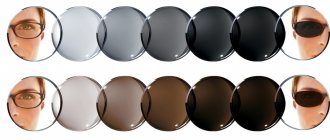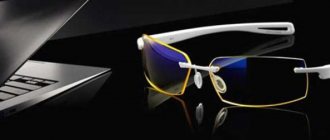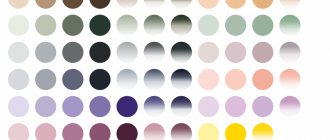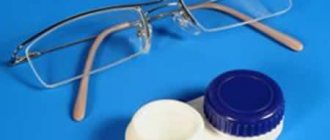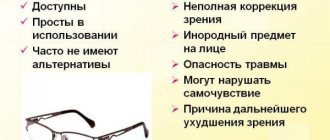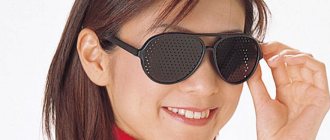Fedorov's perforated glasses have been known in ophthalmology for decades, but they have become popular only in recent years. This is due to the fact that modern people are forced to spend most of their time at computers. Because of this, the load on the eye organs greatly increases, which provokes the development of myopia, farsightedness and astigmatism. Fedorov's glasses are used for the prevention and treatment of these eye diseases. The principle of their action, the rules of use, as well as possible contraindications for wearing can be found below.
How do Fedorov's glasses affect the visual organ?
The training glasses are made of a plastic base. Instead of conventional corrective lenses, the trainer is equipped with opaque lenses, but with many holes, which have a diameter of 1–2 mm and are located hexagonally. How does this affect vision sharpness? When a person looks at an object through such holes, the emitted light is directed past the central optical axis, hitting the retina itself. At this time, small holes in the lens help the light flux to be apertured. The sharpness of the image in the retina begins to increase and it becomes clearer.
If such glasses are used by people with pathology in the form of farsightedness or myopia, their retina receives a clear, but bifurcated image of the object in question (without glasses the image will have a blurry appearance). A special optical system located in the eye organ begins to record these deviations and sends information to the brain. Next, the brain sends a signal to the ciliary muscles, which help change the curvature of the lens. In the toga, the split image begins to transform into a clearer one.
The above process contributes to:
- prevent the formation of muscle atrophy;
- normalization of metabolism in the eye organ;
- slows down processes that affect the elasticity of the lens.
A person who does not have vision problems, but with frequent loads on the eye organ, can use Fedorov’s glasses for preventive purposes against the development of astigmatism, glaucoma and cataracts. This will significantly reduce the risk of developing these pathologies in the future.
Purchase Features
Today, the range of computer glasses presented by various manufacturers is huge. But when choosing glasses, the manufacturer is not as important as following some recommendations.
- Before purchasing glasses, undergo an examination and consult an ophthalmologist. The doctor will tell you what glasses are needed, taking into account the condition of the eyes and the purpose of purchase.
- Take into account the specifics of the work: for working with texts, glasses that dull the contrast (to relieve fatigue) are suitable, and for processing graphic images, glasses that enhance the brightness of colors are suitable.
- Choose glasses with light and comfortable frames: there should be no feeling of constriction in the bridge of the nose, on the temples and behind the ears (otherwise your health will worsen).
- Buy glasses at specialized optical outlets. Glasses of dubious quality will not bring any benefit, but only harm.
If you notice that your eyes get tired quickly when wearing glasses, it is better to change your optical device after consulting with your dentist.
Treatment and prevention with glasses
In cases where the doctor recommends using Fedorov's glasses for a while, this will not mean the presence of serious vision problems. Rather, the device was recommended for vision correction and support. This is especially important for patients who spend a long time at the computer. Their eye muscles begin to weaken, and their visual acuity decreases over time. These could be people whose profession is related to computer programs, as well as children who are forced to sit at the computer for a long time due to modern teaching methods. Also in the risk category are people who have a profession related to small details and precision.
Fedorov computer glasses
Fedorov computer glasses are prescribed if the patient has the following anomalies of the eye organs:
- presbyopia – impaired refraction of the eyes, when the patient is unable to clearly see small objects or small print at close range (short arm disease most often develops after 40, but constant overstrain of the eye organ can trigger the development of the disease much earlier);
- photophobia and increased lacrimation;
- myopia of any form (false or true);
- asthenopia in all its forms - manifests itself as a pathological condition with all the subjective symptoms of visual fatigue.
The impact of Fedorov’s computer glasses on the visual system contributes to:
- The tone of the visual muscles decreases, which helps relieve eye fatigue after excessive stress on the eye organ in school and preschool children, teachers, students, as well as fans of long periods of watching TV and computer games.
- They help people with problems with distracted attention and frequent drowsiness to concentrate.
- By ensuring relaxation of the muscles of the eye organ, they help relax the entire body.
- Visual muscle training is therefore often recommended for children with a genetic predisposition to developing farsightedness or myopia.
- The ability to relieve increased eye fatigue makes it possible to prescribe glasses to patients who often experience neurotic conditions.
Due to this effect, the simulator is often prescribed for preventive purposes.
Fedorov glasses for children
Fedorov's glasses to improve vision are allowed in pediatric ophthalmology. They are often prescribed for increased levels of UV (ultraviolet radiation) on the cornea and lens of the child’s eye organ, as well as to reduce the tone of the eye muscles in order to prevent farsightedness and myopia.
Why do I need them?
The computer has become so firmly established in our lives that sometimes we spend a lot of time in front of the monitor, even at home, not to mention at work.
Such actions do not have the best effect on the body, in particular on vision. Due to excessive concentration, the cornea dries out; in addition, a person sitting at a computer blinks much less often, and all this leads to a burning sensation in the eyes, their rapid fatigue and redness. All these are the results of increased visual load.
To protect your eyes and preserve your vision, every person who spends several hours in a row in front of a monitor must follow several rules:
- sit at a distance of 50 cm from the monitor;
- Every 30 minutes, do eye exercises, look far away;
- every hour get up from the table, do a minute warm-up (move your head, arms, bend over);
- From time to time, use moisturizing eye drops designed to protect the mucous membrane from drying out.
Failure to follow these simple recommendations leads to a deterioration in visual function, and then to the development of computer vision syndrome, the main symptoms of which are:
- visual strain;
- eye fatigue;
- blurred contours of visible images;
- ghosting;
- irritation and dry eyes;
- headaches that get worse over time;
- regular pain in the neck.
Relatively recently, together with Academician S. N. Fedorov, special computer glasses were developed that can minimize harmful effects on the eyes and make long-term work at the computer comfortable.
Possible contraindications for Fedorov glasses
Fedorov's glasses are a kind of simulator for the eye muscles. Like any other exercise machine, they also have their contraindications. If they are not studied or ignored, the existing vision problem can be significantly worsened.
I would also like to note that not every person knows about the actual state of their eyes. More than one experiment was carried out. People agreed to undergo examination with the belief that they did not have problems related to the health of the eye organ. Based on the results of the simplest diagnostic methods, half of them were found to have certain abnormalities. Therefore, if you spend a lot of time at the computer and often feel tired eyes, you should not purchase this product yourself without preliminary diagnosis.
The main contraindications and reasons for limiting the use of glasses include:
- nystagmus - involuntary repeated vibrations of the eyeball with a pendulum-like movement;
- frequent increase in intraocular or intracranial pressure;
- the presence of glaucoma in a progressive stage;
- infectious diseases of the eye organs, accompanied by inflammatory processes, were discovered;
- The patient has strabismus.
Other deviations in the development of the eye organ cannot be a contraindication to the prescription of glasses. On the contrary, the development of many ophthalmological diseases can be prevented or delayed with the help of this simulator. Glasses are equally often recommended in both adult and pediatric ophthalmology.
Possible contraindications
Training glasses have certain restrictions on use, including:
- increased intracranial or intraocular pressure;
- involuntary twitching of the eyeballs (nystagmus);
- progressive glaucoma;
- strabismus;
- eye infections;
- inflammatory eye diseases.
Despite the fact that wearing the product has a beneficial effect on visual function, you should consult with an ophthalmologist before purchasing it.
Advantages of Fedorov glasses in comparison with similar products
The modern market offers many options for training glasses. Each of them has its own characteristics. The advantages of the glasses we are considering are as follows:
- The holes are cone-shaped, and the lens itself is slightly thicker. This helps reduce glare and increase the effect, compared to the classic cylindrical shapes of the holes found in other types.
- The thickness of the plate, the location of the holes in it, as well as their sizes, ensure the fastest possible adaptation to the design and increase the positive effect.
- The depth of focus is distributed as evenly as possible thanks to the plane of the lenses and horizontally located holes.
Another feature of Fedorov’s glasses is the presence of a “window” at the bottom. This allows the eyeball to receive additional dim lighting and thereby improve hemodynamics.
Important: The presence of such a window will be appreciated by people with myopia pathology. They will be able to read, write or sew with the simulator.
Rules for using glasses
When you put on Fedorov’s glasses for the first time, your first thoughts are nothing visible, zero effect, wasted money. The thing is that this design differs from conventional corrective glasses. You need to get used to it. Getting used to it can last from two weeks to a month, but don’t give up, the result is worth it.
So, for the first week, glasses are put on 3 times a day for 5 minutes. It is desirable that there is sufficient lighting in the room. In case of severe discomfort, the time between procedures is increased to four hours. After this time has been maintained without unnecessary strain on the eyes, it can be slightly increased.
Throughout the entire adaptation period, the time of wearing the simulator increases to the norm - 40 minutes per day. This time can be devoted to reading or working at the monitor, but with the conditions - sufficient lighting and stopping your gaze in the direction of one point is prohibited. The eyes should be in constant motion. Otherwise, the eye muscles begin to feel overloaded.
Some patients stop using computer glasses, citing their ineffectiveness. To achieve good results, the entire course must be continued for a year. During this time, the simulator is used for 250 hours. Only in this case will the effect be noticeable.
Set of exercises
Training glasses are used in combination with specially selected exercises. You need to start doing them after your eyes have fully adapted to the simulator itself. This can be determined by the quality of vision. If the recorded picture is viewed as with conventional corrective glasses, the adaptation was successful and you can proceed to the second stage - adding exercises.
Important: Before starting the exercises, provide the room with good lighting.
- Muscle relaxation. The eyes are closed and relaxed for 10 seconds (this relaxation will need to be repeated at the end of each exercise).
- At a distance of 30 cm from the eyes, place your hand with a raised finger. Without straining the eye muscles, we direct our gaze into the distance for 3 seconds and return it to the tip of the raised finger for another 5 seconds. The repetition occurs 10 times.
- Then we close our eyes tightly 8 times and open our eyes, rotate them around, concentrate our attention on the top of the pencil, which is slowly approaching and moving away from the face.
- Repeat the exercise 8 times. You need to fix your gaze on the tip of the finger of your outstretched hand. We bring our hand closer, without taking our eyes away until the object doubles.
- We examine the same finger of an outstretched hand for about 5 seconds, but first covering one eye with our palm. Then we look for 5 seconds with both eyes and cover the other.
- We put our palm in front and slowly move it from side to side. The task is to follow the palm with your eyes without turning your head. Regularity 10 times.
- A mark 2–3 mm in diameter is fixed on the window glass. The patient stands 30–35 cm from the window and selects a mark far away outside the window. Now you need to look at these two marks alternately for 10 seconds. Every day this time increases by 30 seconds. A week later, the exercise is repeated for 7 minutes.
After completing all the exercises, the simulator is removed. Now you need to blink a little and massage your eyelids with light movements. This will help improve blood circulation in the eye organ.
Many people are interested in the question of whether it is possible to combine training with going outside or driving. Experts do not recommend it, but you can find out more from your doctor.
Choosing quality glasses
Unfortunately, recently a lot of Chinese counterfeits have appeared on the market, which do not meet the standards. Such simulators, at best, may not provide the desired effect, but at worst, they may aggravate the existing problem.
The main criteria based on which you can choose a quality product. Pay attention to the frame. For its manufacture, a rigid material had to be used that would not allow the frame to deform during transportation. Any flaws in the design or irregularities indicate a fake.
The trainer fits snugly on the bridge of the nose, but does not squeeze it. Wearing must be comfortable. To do this, it is better to try on the product and stand in it for a couple of seconds. Pay attention to the holes and their location. The rows with them should be straight and even.
Price – high-quality Fedorov glasses will cost about 700 rubles. Cheap options may be fake or contain defects.
Sources used:
- Tovbin, B.G. Refraction. Accommodation. Selection of points / B.G. Tovbin. - M.: Yoyo Media, 2013.
- Skoromets A. A. Topical diagnosis of diseases of the nervous system: A guide for doctors. — 1st ed. - L.: Medicine, 1989
- Belyaev, V.S. Operations on the cornea and sclera / V.S. Belyaev. - M.: Medicine, 1984.
- Wikipedia article
